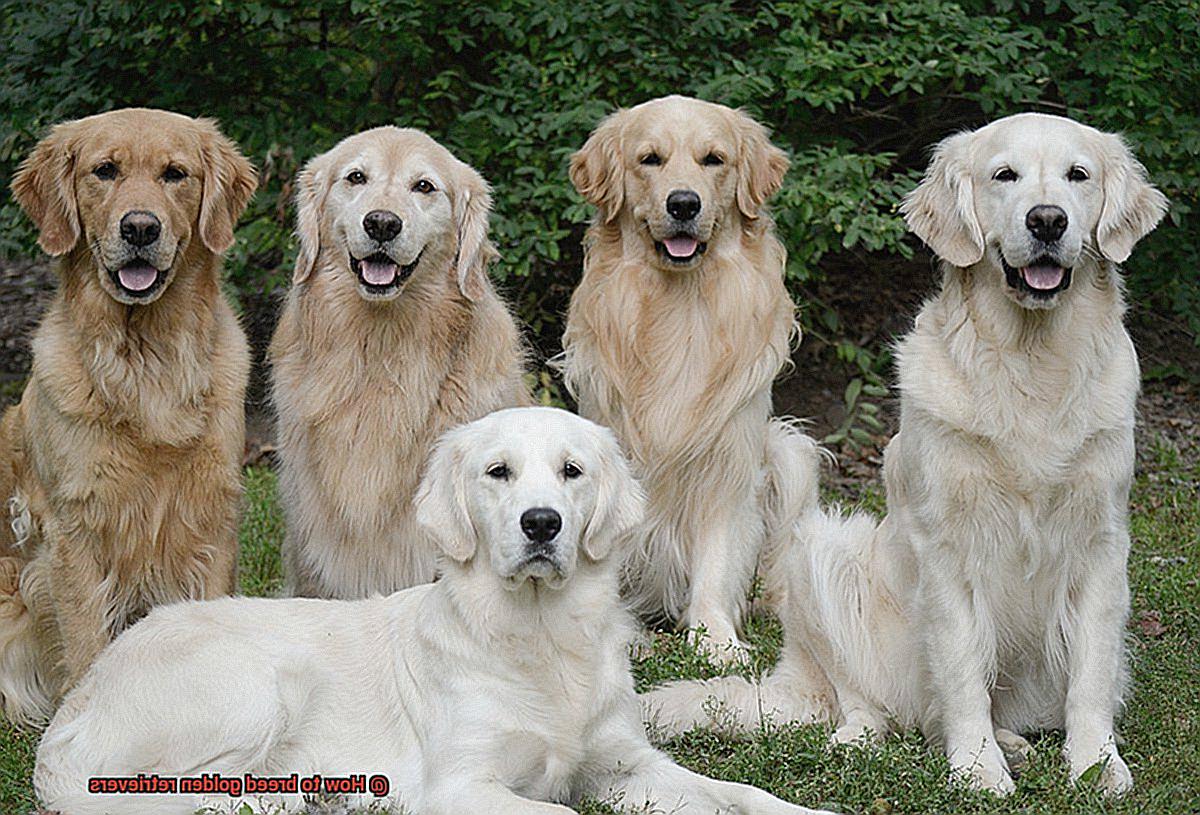Golden Retrievers are more than just a breed of dog – they’re loyal, versatile, and loving companions. Whether you’re looking for a family pet, service dog, or hunting companion, these beautiful creatures are sure to steal your heart. And if you’re interested in learning how to breed them, then you’ve come to the right place.
Breeding Golden Retrievers is not for the faint of heart. It takes dedication, patience, and hard work to successfully bring new puppies into the world. But with the right tools and information at your disposal, you can become a successful breeder and make a difference in the lives of these amazing dogs.
So where do you start? In this informative post, we’ll walk you through all the essential steps needed to breed Golden Retrievers. From selecting the perfect pair of dogs to preparing for mating season, we’ll cover everything you need to know to ensure that your breeding journey is a success.
Whether you’re an experienced breeder or just starting out on this exciting journey, this post is an invaluable resource that will guide you through every step of the process. So buckle up and get ready for an adventure into the world of Golden Retriever breeding.

Understanding the Breed Standard
Contents
If you’re thinking of breeding golden retrievers, you need to consider many factors. One of the most crucial is understanding the breed standard. The American Kennel Club (AKC) has established a set of guidelines that define the ideal physical characteristics, temperament, and behavior of the breed. By adhering to these standards, you can guarantee that your breeding program produces puppies that are healthy, well-behaved, and physically sound.
The AKC breed standard states that golden retrievers should have a friendly and eager-to-please temperament. They should be confident, kind, and intelligent with a love for people and other animals. The ideal physical appearance includes medium-sized dogs with a dense, water-repellent coat that ranges in color from cream to dark golden. They should have a broad skull, well-set ears, and a powerful neck and shoulders.
When selecting breeding dogs, it’s essential to choose those that meet the breed standard. This means selecting dogs with good temperaments, sound structures, and healthy genetics. Breeding dogs that do not meet these standards can result in puppies with health problems or behavioral issues that may negatively impact their quality of life.
If you want to ensure that your breeding program produces high-quality puppies that meet the breed standard, there are several steps you can take. Consult with experienced breeders, attend dog shows and events, and conduct health screenings on your breeding dogs. Researching the pedigrees of potential breeding pairs is also crucial to ensure they are not closely related and do not carry any genetic defects.
Selecting Breeding Partners
Breeding golden retrievers is a labor of love. It takes more than just selecting any two dogs and hoping for the best. One of the most important steps in breeding is selecting the right partners. This is where thorough research and careful consideration come into play.
Firstly, choosing healthy breeding partners is paramount. To ensure that their offspring are free from genetic health issues, both dogs should undergo health screenings and genetic testing. This is a critical step in safeguarding the long-term well-being of the breed.
In addition to health, desirable traits such as good temperament, intelligence, and athleticism are essential for the puppies’ well-being and their future owners’ satisfaction. After all, nobody wants a dog with a poor temperament or lack of intelligence.
The breed standard should also be taken into account when selecting breeding partners. This standard outlines the physical characteristics typical of golden retrievers, including coat color and texture, size, and shape. By choosing partners that conform to this standard, breeders can increase the chances of producing puppies that meet customers’ expectations.
Bloodline is another crucial factor to consider when selecting breeding partners. Inbreeding can lead to health problems in offspring, so it’s best to choose dogs from different bloodlines. This not only helps ensure better health outcomes but also promotes genetic diversity within the breed.
Last but not least, compatibility between breeding partners should be taken into account. Dogs that get along well with each other are more likely to produce healthy and happy puppies. Observing potential partners together before breeding can help determine whether they have good chemistry and are comfortable with each other.

Timing the Breeding Process
Breeding golden retrievers is an exciting and fulfilling experience that requires a lot of planning and attention to detail. Timing, in particular, is a critical aspect of the breeding process that can make all the difference. In this article, we’ll explore why timing is so vital and how you can ensure a successful and healthy litter of puppies.
To begin with, it’s crucial to choose the right age for breeding. Female golden retrievers should be between 2 and 5 years old, while males should be at least 2 years old. It’s also important to avoid breeding a female during her first heat cycle, as her body may not yet be mature enough to handle a pregnancy.
Before breeding, both dogs should undergo health checks and genetic testing to ensure they are free from any inherited diseases or conditions that could affect their offspring. It’s also essential to make sure that both dogs are up-to-date on vaccinations and parasite prevention medication.
When it comes to the actual breeding process, timing is everything. The ideal time for breeding is when the female is in her estrus stage, which typically occurs around day 12-14 of her cycle. During this time, the female’s vaginal discharge becomes more transparent, and she may show more interest in males.

To determine when the female is ready for breeding, it’s crucial to monitor her temperature daily. A sudden drop in temperature may indicate that she has ovulated and is ready for breeding.
After the female has been bred, it’s recommended to have progesterone levels checked to confirm her pregnancy. This can help you determine the best time for delivery and ensure that your puppies are born healthy.
Pre-breeding Preparation
Your furry companions deserve the best care possible, and ensuring that both the male and female dogs are healthy and free from any genetic or hereditary diseases is an excellent place to start. The first step in pre-breeding preparation is conducting a thorough health screening for both dogs, which includes tests for hip dysplasia, elbow dysplasia, eye problems, and heart conditions.
Another critical aspect of pre-breeding preparation is ensuring that your dogs are up-to-date on their vaccinations and have been dewormed. This step is crucial because it prevents any potential infections or illnesses that could harm the puppies or the mother during pregnancy and delivery.
When it comes to breeding female golden retrievers, timing is everything. While they may reach sexual maturity between 6-12 months of age, it’s recommended to wait until they are at least 2 years old before breeding them. This waiting period allows them to fully develop both physically and mentally, which ensures a successful pregnancy and healthy puppies.
Working with responsible and reputable breeders is also essential. These breeders prioritize the health and well-being of the dogs over profit and have extensive experience in breeding golden retrievers. They provide a safe and comfortable environment for both the mother and puppies.
Nutrition and Care During Pregnancy
Just like with humans, a healthy and well-balanced diet is crucial for the development of the puppies and the overall health of the mother.
During the first few weeks of pregnancy, it’s essential to feed your golden retriever small meals throughout the day that are rich in high-quality proteins, fats, and carbohydrates. Additionally, vitamins and minerals such as calcium, phosphorus, and iron are fundamental for the growth and development of the puppies.
As the pregnancy progresses, your golden retriever will require more protein and calories to support the growth of her puppies. It’s vital to collaborate with your veterinarian to create a feeding plan that meets her specific nutritional needs.
Apart from proper nutrition, creating a serene and secure environment for your golden retriever is equally important. She should have access to a cozy, warm, and dry area where she can rest and relax. Regular exercise is also critical for maintaining her health and promoting healthy circulation.
Regular veterinary check-ups are also essential during pregnancy. Your veterinarian can monitor the progress of the pregnancy, evaluate the health of the mother and puppies, and provide any necessary medical care.
Raising a Healthy Litter of Puppies
Raising a healthy litter of puppies is a big responsibility that requires a lot of time, effort, and knowledge. As an expert in this field, I understand the importance of taking care of both the mother and her offspring throughout the entire process.
To start, it’s crucial to ensure that the breeding pair is healthy and free of any underlying medical conditions that could be passed on to their offspring. Regular veterinary check-ups and genetic testing are highly recommended to prevent any complications before breeding even begins.
Once the breeding process has taken place, it’s important to provide the pregnant golden retriever with the best possible care. A balanced diet rich in protein, fats, carbs, vitamins, and minerals is essential for healthy puppy development. Small meals throughout the day will ensure that the mother is getting enough nutrients while also preventing any digestive issues. Regular exercise and veterinary care are also necessary to monitor the mother’s health and prevent any complications during pregnancy.
After the puppies are born, their health and well-being should be closely monitored. Regular check-ups with a veterinarian, vaccinations, and deworming are necessary to ensure they grow up healthy and strong. Socialization is also crucial during this stage. Exposing them to different people, animals, and environments at an early age can help prevent future behavior problems and ensure they grow up to be friendly dogs.
Choosing the right homes for the puppies is just as important as their health and well-being. Breeders must carefully screen potential owners to ensure they will provide a safe and loving environment for their new furry family member. Providing new owners with information on how to properly care for their new puppy – including training, nutrition, and healthcare – is also crucial for their well-being.
Conclusion
In conclusion, breeding Golden Retrievers is both a fulfilling and challenging task that requires dedication, patience, and hard work. It’s crucial to understand the breed standard when selecting breeding partners and ensuring their offspring are healthy, well-behaved, and physically sound. Timing is also critical in the breeding process – from choosing the right age for breeding to monitoring the female’s temperature to determine when she’s ready for mating.
But before any of this can happen, pre-breeding preparation is essential to ensure both dogs are healthy and free from any genetic or hereditary diseases. Proper nutrition, exercise, and care during pregnancy are crucial for developing healthy puppies while maintaining the mother’s health.
Raising a litter of Golden Retriever puppies requires close attention to their health and well-being. Regular veterinary check-ups, vaccinations, deworming, socialization, and careful screening of potential owners are all necessary steps in ensuring that these furry companions grow up happy and healthy.
As an expert in this field with years of experience under my belt, I know firsthand how rewarding it can be to raise a litter of Golden Retriever puppies. Watching them grow up into loyal companions for loving families is truly one of life’s greatest joys. So if you’re thinking about breeding Golden Retrievers yourself – go for it.









